Influence of Moisture Content and Wet Environment on the Fatigue Behaviour of High-Strength Concrete
Abstract
:1. Introduction
2. Materials and Methods
2.1. Concrete Composition and Specimen Preparation
2.2. Test Programme and Experimental Set-Up
3. Results
3.1. Numbers of Cycles to Failure
3.2. Macroscopic Damage Indicators
3.3. Microstructural Investigations
4. Model for Water-Induced Damage
5. Computational Model
5.1. Mathematical Description of Fatigue Behaviour in Poroelastic Media
5.1.1. Elastic Contribution
5.1.2. Fluid Contribution
5.1.3. Fatigue Contribution
5.2. Poroelastic Simulation to Fatigue Load
6. Conclusions
- The number of cycles to failure showed a significant reduction with increasing moisture contents in the concrete. The largest difference in the numbers of cycles to failure of Δlog10 Nf = 2.5 was found between water-saturated and dried concrete specimens.
- The moisture content in the concrete—and not the water as an environment—was identified as being primarily responsible for accelerated fatigue deterioration of concrete.
- The results for the development of stiffness showed an increased stiffness degradation per load cycle with increasing moisture content. The results indicated additionally the presence of a certain moisture content, beyond which different or additional mechanisms of fatigue damage arise.
- The water-induced fatigue damage was distinguished from conventional fatigue damage based on the occurrence of the AE hits. Compared to specimens stored in a climate chamber, the point of occurrence of AE hits of water-saturated concrete specimens shifts from a maximum to minimum stress level. This difference in the results confirms that additional damage mechanisms are acting with increasing moisture content in concrete, which lead to an accelerated degradation process due to fatigue loading.
- Investigations with respect to the influence of the load frequency show a significant reduction of fatigue resistance and increasing stiffness degradation per load cycle in phase II with decreasing load frequency.
- Considering the moisture distribution results from NMR testing, moisture redistribution and degradation patterns were visible in the size range predicted by Tomann [22] for the wet-fatigue mechanism, confirming this hypothesis.
- The numerical results confirm that the fatigue effect for water-saturated concretes leads to a reduction in the damage resistance compared to dry concretes. The numerical prediction coincides well with the results from experiments.
Author Contributions
Funding
Institutional Review Board Statement
Informed Consent Statement
Data Availability Statement
Acknowledgments
Conflicts of Interest
Appendix A
| Storage Conditions | Moisture Content [mass-%] | fcm,150 [MPa] | ||
|---|---|---|---|---|
| RH1 | HPC-1 | RH1 | HPC-1 | |
| D | ~0 | - | 108 | - |
| C | 3.5 | - | 97 | - |
| M | 4.3 | - | 107 | - |
| WS/WST | 5.0 | 4.0 | 110 | 107 |
| Storage Conditions | ft | Smax | Smin | Nf | log Nf | Mean log Nf |
|---|---|---|---|---|---|---|
| D | 1 | 0.65 | 0.05 | 5,000,000 | 6.70 | 6.70 |
| C | 1 | 0.65 | 0.05 | 199,827 | 5.30 | 5.32 |
| 1 | 0.65 | 0.05 | 217,093 | 5.34 | ||
| M | 1 | 0.65 | 0.05 | 41,258 | 4.62 | 4.51 |
| 1 | 0.65 | 0.05 | 27,030 | 4.43 | ||
| 1 | 0.65 | 0.05 | 36,688 | 4.56 | ||
| 1 | 0.65 | 0.05 | 27,907 | 4.45 | ||
| WS | 1 | 0.65 | 0.05 | 16,581 | 4.22 | 4.27 |
| 1 | 0.65 | 0.05 | 16,534 | 4.22 | ||
| 1 | 0.65 | 0.05 | 28,963 | 4.46 | ||
| 1 | 0.65 | 0.05 | 14,460 | 4.16 | ||
| WST | 1 | 0.65 | 0.05 | 16,331 | 4.21 | 4.20 |
| 1 | 0.65 | 0.05 | 10,485 | 4.02 | ||
| 1 | 0.65 | 0.05 | 22,710 | 4.36 |
| Storage Conditions | ft | Smax | Smin | Nf | log Nf | Mean log Nf |
|---|---|---|---|---|---|---|
| WST | 10 | 0.65 | 0.05 | 24,271 | 4.39 | 4.42 |
| 10 | 0.65 | 0.05 | 31,153 | 4.49 | ||
| 10 | 0.65 | 0.05 | 23,499 | 4.37 | ||
| WST | 5 | 0.65 | 0.05 | 16,208 | 4.21 | 4.22 |
| 5 | 0.65 | 0.05 | 22,887 | 4.36 | ||
| 5 | 0.65 | 0.05 | 12,329 | 4.09 | ||
| WST | 1 | 0.65 | 0.05 | 13,931 | 4.14 | 4.05 |
| 1 | 0.65 | 0.05 | 9944 | 4.00 | ||
| 1 | 0.65 | 0.05 | 10,396 | 4.02 | ||
| WST | 0.35 | 0.65 | 0.05 | 3880 | 3.59 | 3.69 |
| 0.35 | 0.65 | 0.05 | 4494 | 3.65 | ||
| 0.35 | 0.65 | 0.05 | 6779 | 3.83 |
References
- Muguruma, H.; Watanabe, F. On the Low-cycle Compressive Fatigue Behaviour of Concrete under Submerged Condition. In Proceedings of the 27th Japan Congress on Materials Research, Kyoto, Japan, September 1984; pp. 219–224. [Google Scholar]
- Hohberg, R. Zum Ermüdungsverhalten von Beton. [About the Fatigue Behaviour of Concrete]. Ph.D. Thesis, Technische Universität Berlin, Berlin, Germany, 2004. (In German) [Google Scholar] [CrossRef]
- Sørensen, E.V.; Westhof, L.; Yde, E.; Serednicki, A. Fatigue Life of High Performance Grout for Wind Turbine Grouted Connection in Wet or Dry Environment. Paper Presented at EWEA OFFSHORE 2011, Amsterdam, The Netherlands, 29 November–1 December 2011. [Google Scholar]
- Oneschkow, N.; Hümme, J.; Lohaus, L. Compressive fatigue behaviour of high-strength concrete in a dry and wet environment. Constr. Build. Mater. 2020, 262, 119700. [Google Scholar] [CrossRef]
- Hümme, J. Ermüdungsverhalten von hochfestem Beton unter Wasser. Hannover. [Fatigue Behaviour of High-strength Concrete under Water]. Ph.D. Thesis, Leibniz University Hannover, Hannover, Germany, 2018. (In German) [Google Scholar] [CrossRef]
- Hümme, J.; Lohaus, L. Fatigue Behaviour of High-strength Grout in Dry and Wet Environment. In Proceedings of the International Wind Engineering Conference IWEC, Hannover, Germany, 2–3 September 2014. [Google Scholar]
- Nygard, K.; Petković, G.; Rosseland, S.; Stemland, H. The Influence of Moisture Conditions on the Fatigue Strength of Concrete. In High Strength Concrete; SINTEF Structural Engineering—FCB: Trondheim, Norway, 1992. [Google Scholar]
- Oneschkow, N. Analyse des Ermüdungsverhaltens von Beton anhand der Dehnungsentwicklung. [Analysis of the Fatigue Behaviour of Concrete with Respect to the Development of Strain]. Ph.D. Thesis, Leibniz Universität Hannover, Hannover, Germany, 2014. (In German) [Google Scholar] [CrossRef]
- Pesch, A. Ein Beitrag zum zeitabhängigen Verhalten von hochfestem Beton und hochfestem Mörtel [A Contribution to the Time-dependent Behaviour of High-strength Concrete and High-strength Mortar]. Ph.D. Thesis, Technische Hochschule Darmstadt, Darmstadt, Germany, 1997. (In German). [Google Scholar]
- Brosge, S. Beitrag zur Ermüdungsfestigkeit von Hochfestem Beton [Contribution to the Fatigue Strength of High-Strength Concrete]. Ph.D. Thesis, Universität Leipzig, Leipzig, Germany, 2001. (In German). [Google Scholar]
- Peterson, W.S. Fatigue of reinforced concrete in sea water. Spec. Publ. 1980, 65, 419–436. [Google Scholar]
- Aldakheel, F.; Tomann, C.; Lohaus, L.; Wriggers, P. Water-induced failure mechanics for concrete. PAMM 2019, 19, e201900140. [Google Scholar] [CrossRef] [Green Version]
- Tomann, C.; Oneschkow, N. Influence of moisture content in the microstructure on the fatigue deterioration of high-strength concrete. Struct. Concr. 2019, 20, 1204–1211. [Google Scholar] [CrossRef]
- Basaldella, M.; Oneschkow, N.; Ludger, L. Influence of the specimen production and preparation on the compressive strength and the fatigue resistance of HPC and UHPC. Mater. Struct. 2021, 54, 1–14. [Google Scholar] [CrossRef]
- German Institute for Standardization. DIN EN 12390-3:2019-10. Testing Hardened Concrete—Part 3: Compressive Strength of Test Specimens; German Version of EN 12390-3:2019; Beuth: Berlin, Germany, 2019. [Google Scholar]
- German Institute for Standardization. DIN EN ISO 7500-1:2018-06. Metallic Materials—Calibration and Verification of Static Uniaxial Testing Machines—Part 1: Tension/Compression Testing Machines—Calibration and Verification of the Force-Measuring System; German Version of EN ISO 7500-1:2018; Beuth: Berlin, Germany, 2018. [Google Scholar]
- Tomann, C.; Lohaus, L.; Aldakheel, F.; Wriggers, P. Influence of Water-induced Damage Mechanisms on the Fatigue Deterioration of High-strength Concrete. In Proceedings of the fib Symposium 2019: Concrete—Innovations in Materials, Design and Structures, Krakow, Poland, 27–29 May 2019. [Google Scholar]
- Hardy, E.H. NMR Methods for the Investigation of Structure and Transport; Springer: Berlin/Heidelberg, Germany, 2012. [Google Scholar]
- Wyrzykowski, M.; McDonald, P.J.; Scrivener, K.L.; Lura, P. Water Redistribution within the Microstructure of Cementitious Materials due to Temperature Changes Studied with 1H NMR. J. Phys. Chem. C 2017, 121, 27950–27962. [Google Scholar] [CrossRef] [Green Version]
- Radel, B.; Hardy, E.H.; Djuric, Z.; Mahlbacher, M.; Haist, M.; Müller, H.S. Regularized inversion of the Laplace transform for series of experiments. Magn. Reson. Chem. 2019, 57, 836–844. [Google Scholar] [CrossRef] [Green Version]
- Valori, A.; McDonald, P.J.; Scrivener, K.L. The morphology of C–S–H: Lessons from 1H nuclear magnetic resonance relaxometry. Cement Concr. Res. 2021, 49, 65–81. [Google Scholar] [CrossRef] [Green Version]
- Tomann, C. Wasserinduzierte Ermüdungsschädigung von Beton. [Water-induced Fatigue Damage of Concrete]. Ph.D. Thesis, Leibniz Universität Hannover, Hannover, Germany, 2014. (In German) [Google Scholar] [CrossRef]
- DNVGL Offshore Standards. DNV-ST-C502 Offshore Concrete Structures; DNV GL: Oslo, Norway, 2018. [Google Scholar]
- Fédération International du Béton. Fib Model Code for Concrete Structures 2010; Ernst & Sohn: Berlin, Germany, 2013. [Google Scholar] [CrossRef]
- Markert, M.; Veit, B.; Garrecht, H. Temperature and Humidity Induced Damage Processes in Concrete Due to Pure Compressive Fatigue Loading. In Proceedings of the fib Symposium 2019: Concrete—Innovations in Materials, Design and Structures, Krakow, Poland, 27–29 May 2019. [Google Scholar]
- Markert, M.; Veit, B.; Garrecht, H. Influence of Concrete Humidity on the Temperature Development under Fatigue Compressive Loading. In Proceedings of the IOP Conference Series: Materials Science and Engineering, Stuttgart, Germany, 30 September–2 October 2019; IOP Publishing: Bristol, UK, 2019. [Google Scholar] [CrossRef] [Green Version]
- Oneschkow, N. Fatigue behaviour of high-strength concrete with respect to strain and stiffness. Int. J. Fatigue 2016, 87, 38–49. [Google Scholar] [CrossRef]
- Noii, N.; Fan, M.; Wick, T.; Jin, Y. A quasi-monolithic phase-field description for orthotropic anisotropic fracture with adaptive mesh refinement and primal–dual active set method. Eng. Fract. Mech. 2021, 258, 108060. [Google Scholar] [CrossRef]
- Noii, N.; Khodadadian, A.; Ulloa, J.; Aldakheel, F.; Wick, T.; Francois, S.; Wriggers, P. Bayesian inversion for unified ductile phase-field fracture. Comput. Mech. 2021, 68, 943–980. [Google Scholar] [CrossRef]
- Aldakheel, F. A microscale model for concrete failure in poro-elasto-plastic media. Theor. Appl. Fract. Mech. 2020, 107, 102517. [Google Scholar] [CrossRef]
- Noii, N.; Khodadadian, A.; Wick, T. Bayesian inversion for anisotropic hydraulic phase-field fracture. Comput. Method Appl. Mech. Eng. 2021, 386, 114118. [Google Scholar] [CrossRef]
- Aldakheel, F.; Noii, N.; Wick, T.; Wriggers, P. A global–local approach for hydraulic phase-field fracture in poroelastic media. Comput. Math. Appl. 2020, 91, 99–121. [Google Scholar] [CrossRef]
- Aldakheel, F.; Noii, N.; Wick, T.; Allix, O.; Wriggers, P. Multilevel global–local techniques for adaptive ductile phase-field fracture. Comput Method Appl. Mech. Eng. 2021, 387, 114175. [Google Scholar] [CrossRef]
- Wriggers, P.; Aldakheel, F.; Lohaus, L.; Haist, M. Water-induced damage mechanisms of cyclically loaded high-performance concretes. Bauingenieur 2020, 95, 126–132. [Google Scholar] [CrossRef]
- Ulloa, J.; Wambacq, J.; Alessi, R.; Degrande, G.; François, S. Phase-field modeling of fatigue coupled to cyclic plasticity in an energetic formulation. Comput. Method Appl. Mech. Eng. 2020, 373, 113473. [Google Scholar] [CrossRef]
- Carrara, P.; Ambati, M.; Alessi, R.; De Lorenzis, L. A framework to model the fatigue behavior of brittle materials based on a variational phase-field approach. Comput. Method Appl. Mech. Eng. 2019, 361, 112731. [Google Scholar] [CrossRef]
- Storm, J.; Pise, M.; Brands, D.; Schröder, J.; Kaliske, M. A comparative study of micro-mechanical models for fiber pullout behavior of reinforced high performance concrete. Eng. Fract. Mech. 2020, 243, 107506. [Google Scholar] [CrossRef]
- Pise, M.; Brands, D.; Sarhil, M.; Schröder, J. Numerical Calibration of Elasto-plastic Phase-field Modeling of Fracture for Experimental Pullout Tests of Single Steel Fibers Embedded in High-performance Concrete. In Proceedings of the SEMC2019: The Seventh International Conference on Structural Engineering, Mechanics and Computation, Cape Town, South Africa, 2–4 September 2019; Zingoni, A., Ed.; CRC Press: London, UK, 2019. [Google Scholar] [CrossRef]
- Schreiber, C.; Kuhn, C.; Müller, R.; Zohdi, T.I. A phase field modeling approach of cyclic fatigue crack growth. Int. J. Fract. 2020, 225, 89–100. [Google Scholar] [CrossRef]
- Seiler, M.; Keller, S.; Kashaev, N.; Klusemann, B.; Kästner, M. Phase-field modelling for fatigue crack growth under laser shock peening-induced residual stresses. Arch. Appl. Mech. 2021, 91, 3709–3723. [Google Scholar] [CrossRef]
- Gebuhr, G.; Pise, M.; Sarhil, M.; Anders, S.; Brands, D.; Schröder, J. Deterioration Development of Steel Fibre Reinforced High performance Concrete in Low-cycle Fatigue. In Proceedings of the SEMC2019: The Seventh International Conference on Structural Engineering, Mechanics and Computation, Cape Town, South Africa, 2–4 September 2019; Zingoni, A., Ed.; CRC Press: London, UK, 2019. [Google Scholar] [CrossRef]

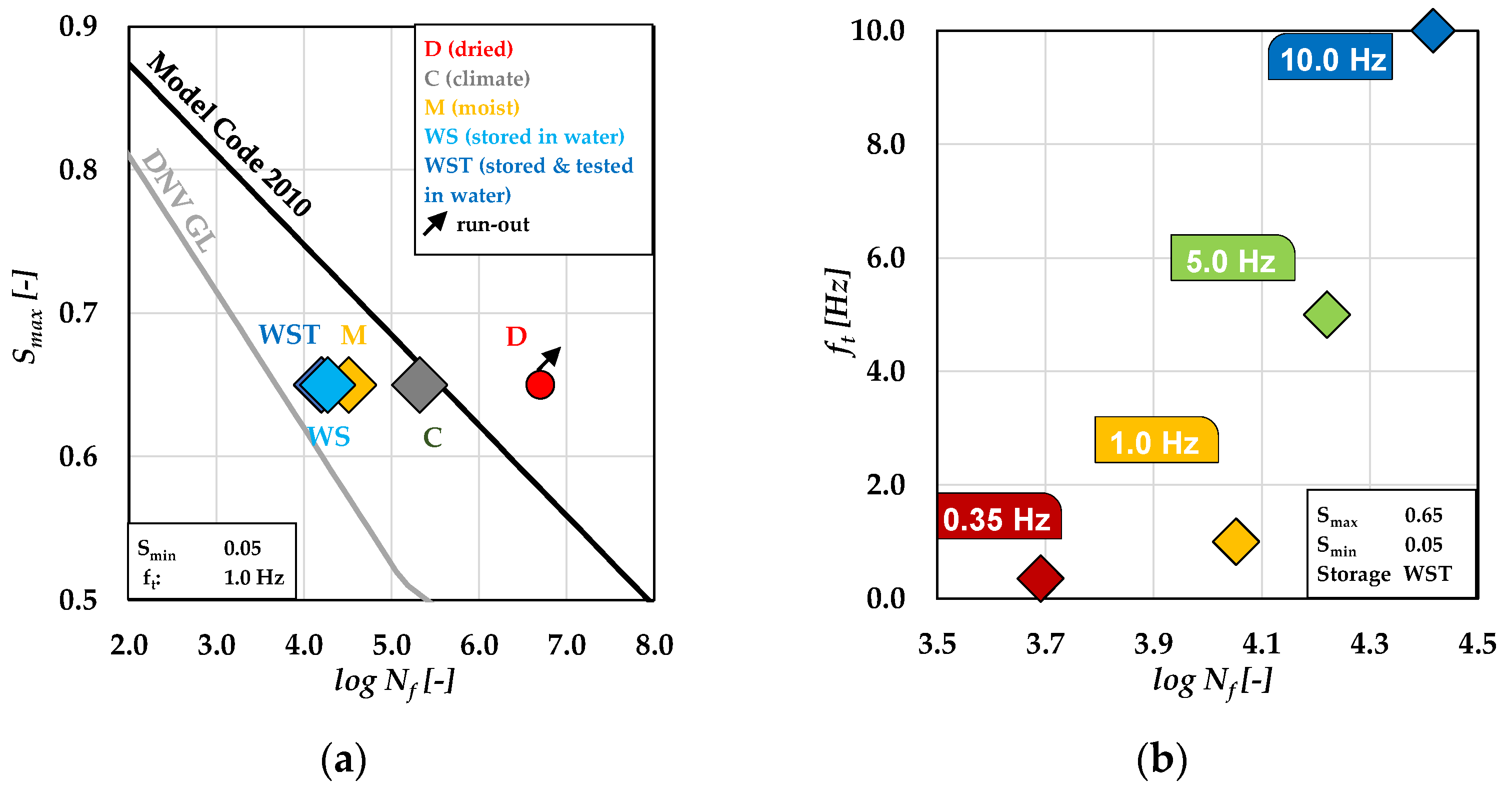
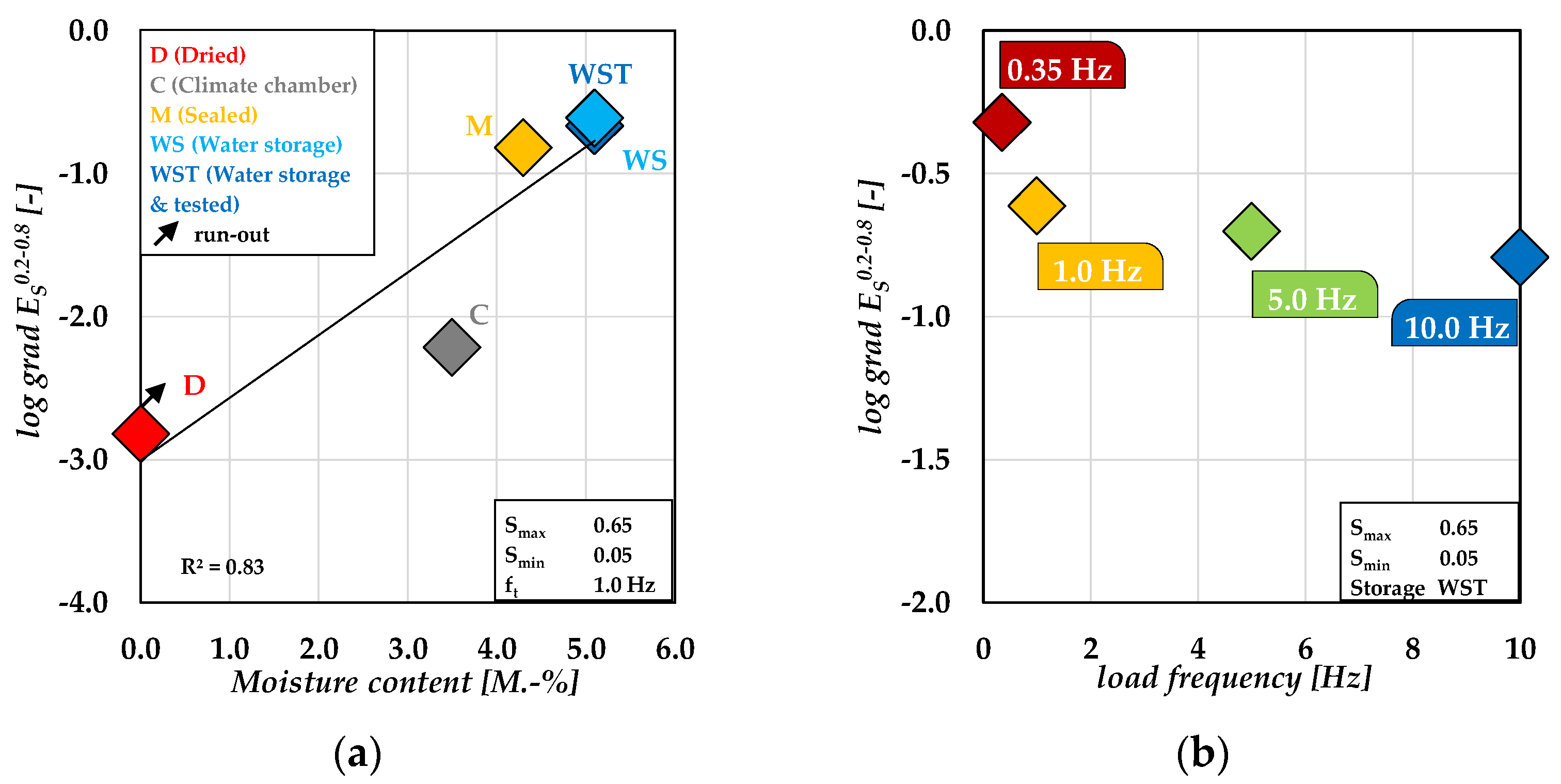
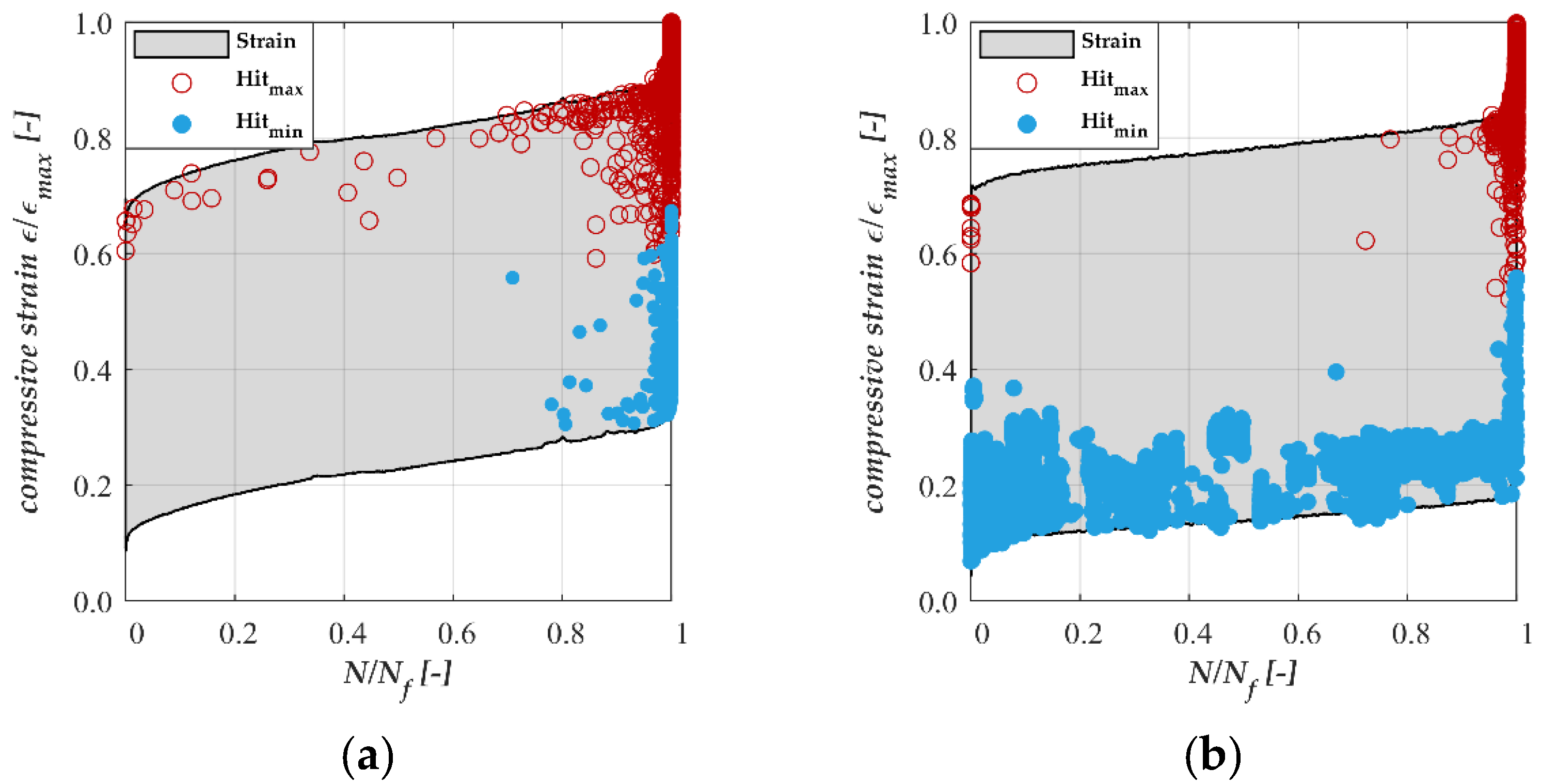
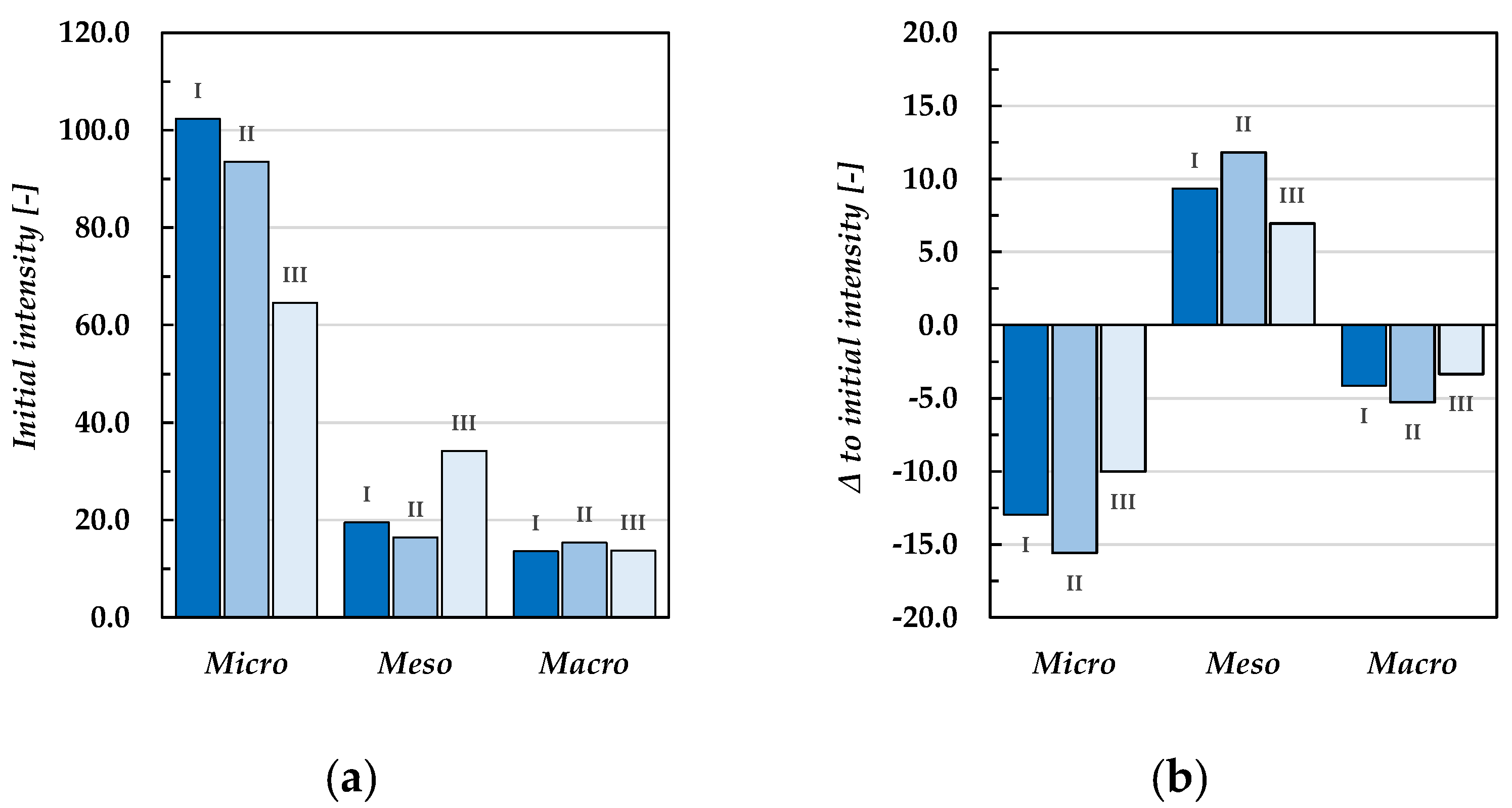

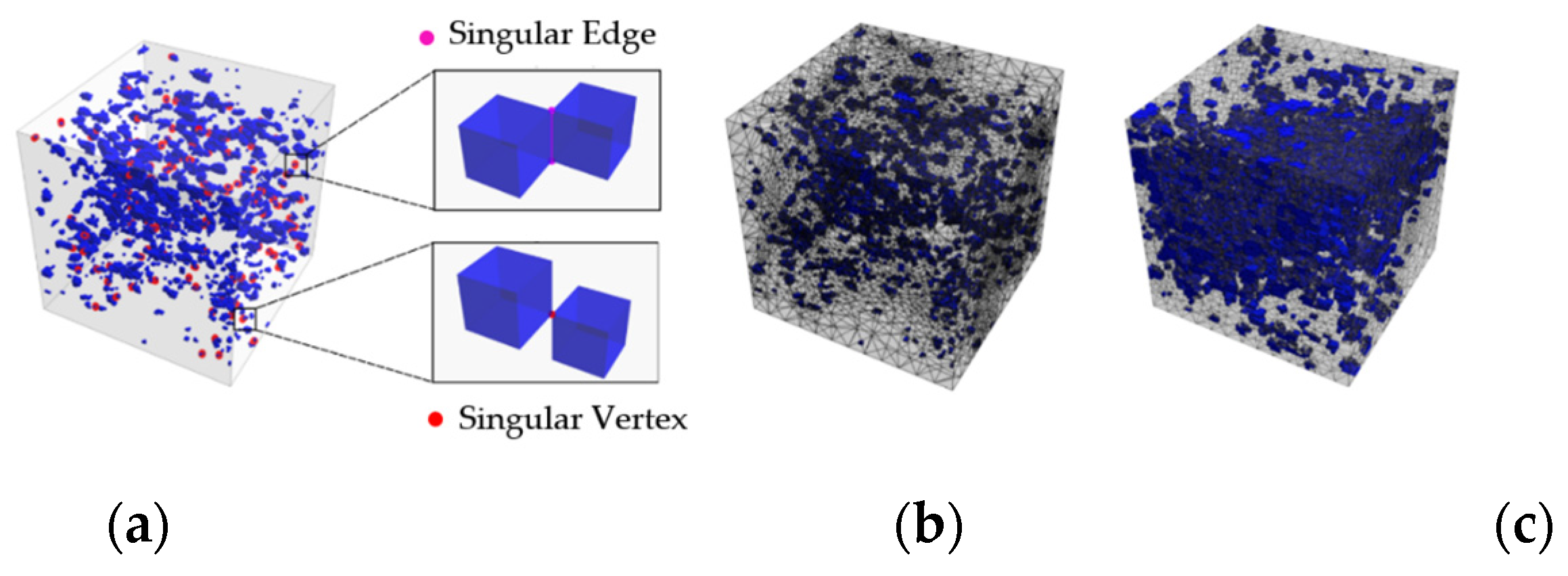
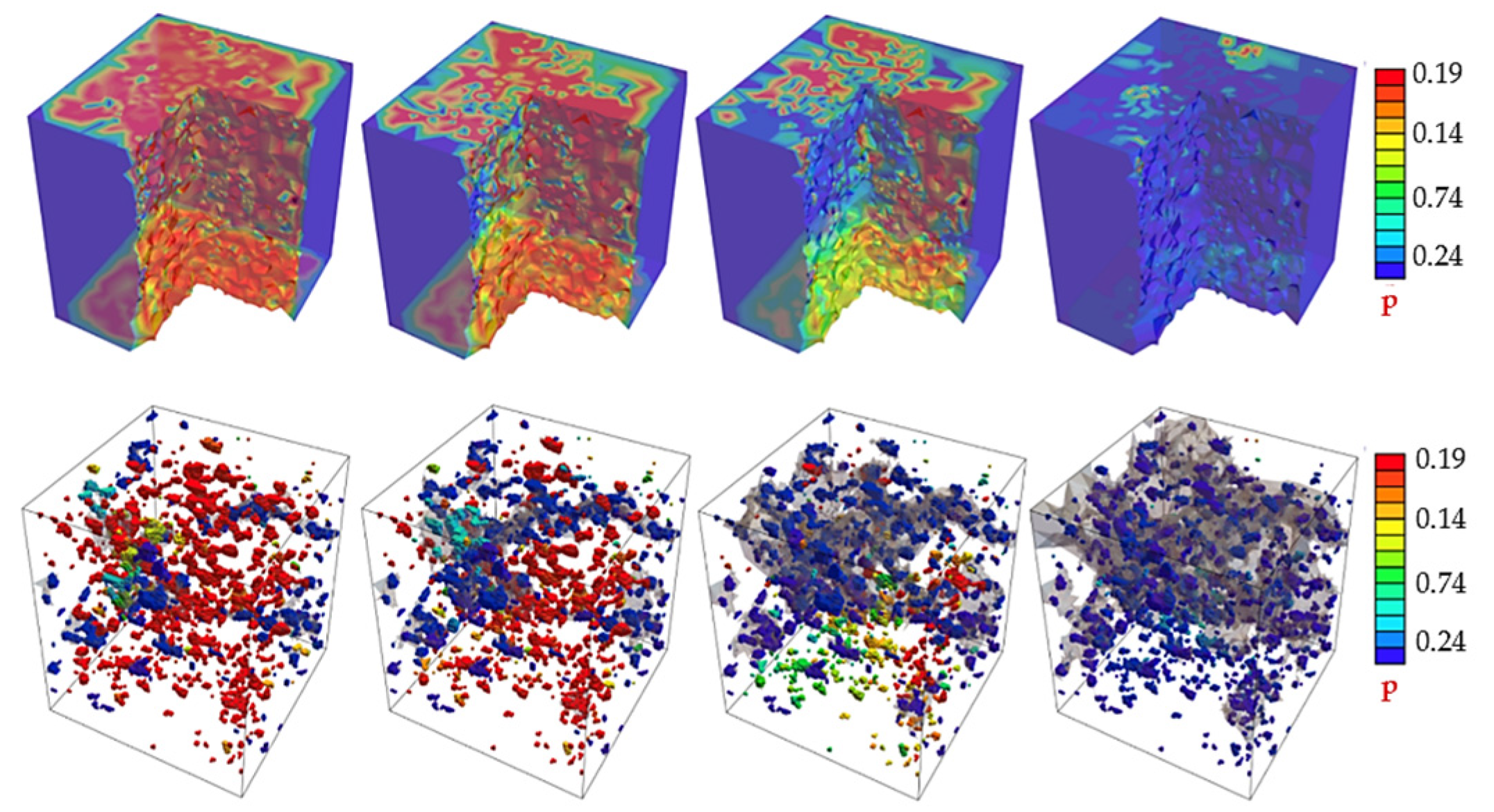
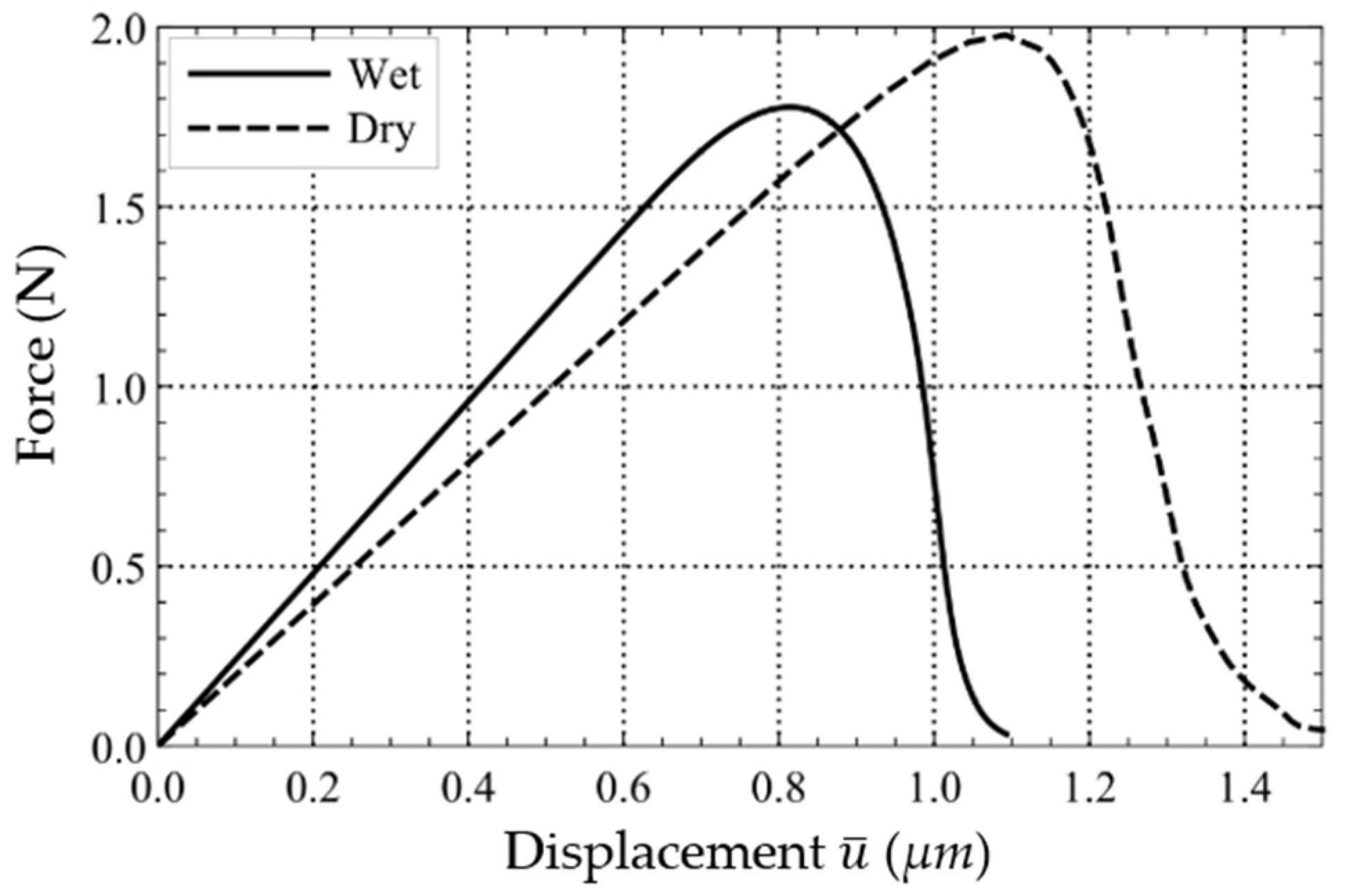

| Components | Content (kg/m3) |
|---|---|
| CEM I 52.5 R-HS/NA (Holcim Sulfo, Lägerdorf, Germany) | 500 |
| Quartz sand (0/0.5 mm) (Quarzwerke H33, Haltern, Germany) | 75 |
| Sand (0/2 mm) (Tündern, Germany) | 850 |
| Basalt (2/5 mm) (Ölberg, Germany) | 350 |
| Basalt (5/8 mm) (Ölberg, Germany) | 570 |
| Superplasticiser (BASF MasterGlenium® ACE 460) | 5.00 |
| Stabiliser (BASF MasterMatrix® SDC 100) | 2.85 |
| Water | 176 |
| Acronym | Storage Conditions | Test Conditions |
|---|---|---|
| D | Dried | Sealed |
| C | Climate chamber | Sealed |
| M | Sealed | Sealed |
| WS | Water storage | Sealed |
| WST | Water storage | Underwater |
| Concrete | Load Frequency ft | Number of Fatigue Tests per Storage Condition | ||||
|---|---|---|---|---|---|---|
| D | C | M | WS | WST | ||
| RH1-B | 0.35 Hz | - | - | - | - | 3 |
| RH1-B/HPC-1 | 1 Hz | 1 | 2 | 4 | 4 | 3/3 |
| RH1-B | 5.0 Hz | - | - | - | - | 3 |
| RH1-B | 10.0 Hz | - | - | - | - | 3 |
Publisher’s Note: MDPI stays neutral with regard to jurisdictional claims in published maps and institutional affiliations. |
© 2022 by the authors. Licensee MDPI, Basel, Switzerland. This article is an open access article distributed under the terms and conditions of the Creative Commons Attribution (CC BY) license (https://creativecommons.org/licenses/by/4.0/).
Share and Cite
Abubakar Ali, M.; Tomann, C.; Aldakheel, F.; Mahlbacher, M.; Noii, N.; Oneschkow, N.; Drake, K.-H.; Lohaus, L.; Wriggers, P.; Haist, M. Influence of Moisture Content and Wet Environment on the Fatigue Behaviour of High-Strength Concrete. Materials 2022, 15, 1025. https://doi.org/10.3390/ma15031025
Abubakar Ali M, Tomann C, Aldakheel F, Mahlbacher M, Noii N, Oneschkow N, Drake K-H, Lohaus L, Wriggers P, Haist M. Influence of Moisture Content and Wet Environment on the Fatigue Behaviour of High-Strength Concrete. Materials. 2022; 15(3):1025. https://doi.org/10.3390/ma15031025
Chicago/Turabian StyleAbubakar Ali, Mohamed, Christoph Tomann, Fadi Aldakheel, Markus Mahlbacher, Nima Noii, Nadja Oneschkow, Karl-Heinz Drake, Ludger Lohaus, Peter Wriggers, and Michael Haist. 2022. "Influence of Moisture Content and Wet Environment on the Fatigue Behaviour of High-Strength Concrete" Materials 15, no. 3: 1025. https://doi.org/10.3390/ma15031025
APA StyleAbubakar Ali, M., Tomann, C., Aldakheel, F., Mahlbacher, M., Noii, N., Oneschkow, N., Drake, K.-H., Lohaus, L., Wriggers, P., & Haist, M. (2022). Influence of Moisture Content and Wet Environment on the Fatigue Behaviour of High-Strength Concrete. Materials, 15(3), 1025. https://doi.org/10.3390/ma15031025







